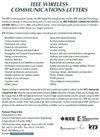Cross-Region Fusion and Fast Adaptation for Multi-Scenario Fingerprint-Based Localization in Cell-Free Massive MIMO Systems
IF 4.6
3区 计算机科学
Q1 COMPUTER SCIENCE, INFORMATION SYSTEMS
引用次数: 0
Abstract
Existing fingerprint-based localization methods perform well in a specific region. However, transferring the model to a new region or adapting to differences in regional environments poses challenges. Additionally, the substantial training cost of the model, including long training time and the inability to reuse data across different regions, further complicates the implementation process. To address these issues, we propose cross region fusion and fast adaptation (CRFA) framework, a novel approach for fingerprint localization in cell-free massive multiple-input multiple-output systems. We begin by extracting angle domain channel power as fingerprint. Further more, we employ access point selection, cross-region fusion and network localization network to enhance localization accuracy and address cross-regional fingerprint disparities. Through the training process of model-agnostic meta-learning, CRFA acquires meta-parameters that facilitate its deployment to any region through a fine-tuning process. Leveraging cross region fusion and meta-learning, the proposed model achieves higher localization accuracy, fast deployment, and adaptability to various environments. Experimental validation using Wireless Insite software shows that the proposed CRFA method performs better in complex environments compared to traditional methods when rapidly deploying models to indoor, urban and suburban region.无小区大规模多输入多输出系统中基于指纹的多场景定位的跨区域融合和快速适应性
现有的基于指纹的定位方法在特定区域表现良好。然而,将模型转移到新的地区或适应地区环境差异带来了挑战。此外,模型的训练成本很高,包括训练时间长和无法在不同地区重复使用数据,这使得实施过程更加复杂。为了解决这些问题,我们提出了跨区域融合和快速适应(CRFA)框架,这是一种在无细胞大规模多输入多输出系统中进行指纹定位的新方法。我们首先提取角域信道功率作为指纹。此外,我们还采用接入点选择、跨区域融合和网络定位网络来提高定位精度,并解决跨区域指纹差异问题。通过与模型无关的元学习(meta-learning)训练过程,CRFA 获得了元参数,通过微调过程便于在任何区域部署。利用跨区域融合和元学习,所提出的模型实现了更高的定位精度、快速部署和对各种环境的适应性。使用 Wireless Insite 软件进行的实验验证表明,与传统方法相比,在将模型快速部署到室内、城市和郊区时,所提出的 CRFA 方法在复杂环境中表现更佳。
本文章由计算机程序翻译,如有差异,请以英文原文为准。
求助全文
约1分钟内获得全文
求助全文
来源期刊

IEEE Wireless Communications Letters
Engineering-Electrical and Electronic Engineering
CiteScore
12.30
自引率
6.30%
发文量
481
期刊介绍:
IEEE Wireless Communications Letters publishes short papers in a rapid publication cycle on advances in the state-of-the-art of wireless communications. Both theoretical contributions (including new techniques, concepts, and analyses) and practical contributions (including system experiments and prototypes, and new applications) are encouraged. This journal focuses on the physical layer and the link layer of wireless communication systems.
 求助内容:
求助内容: 应助结果提醒方式:
应助结果提醒方式:


